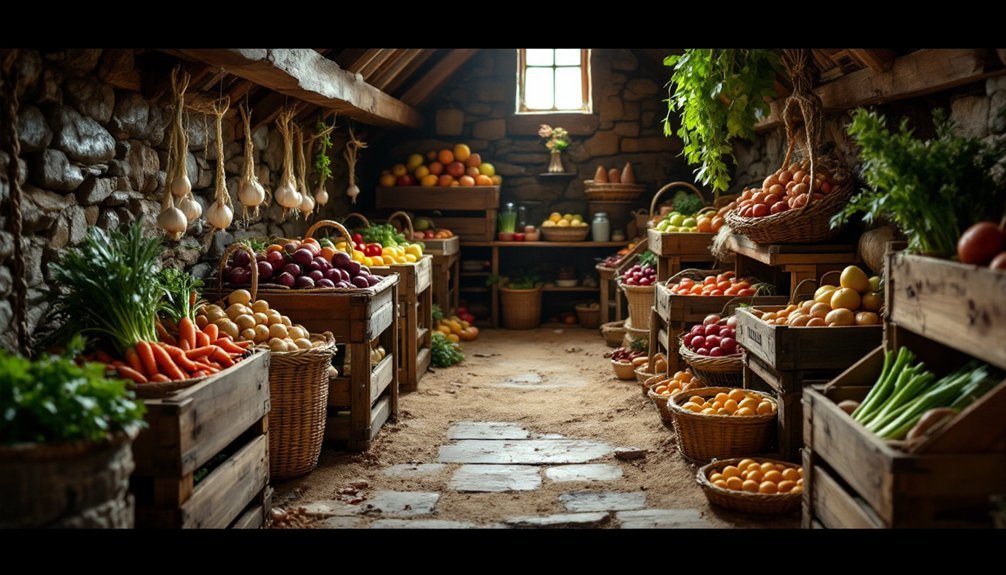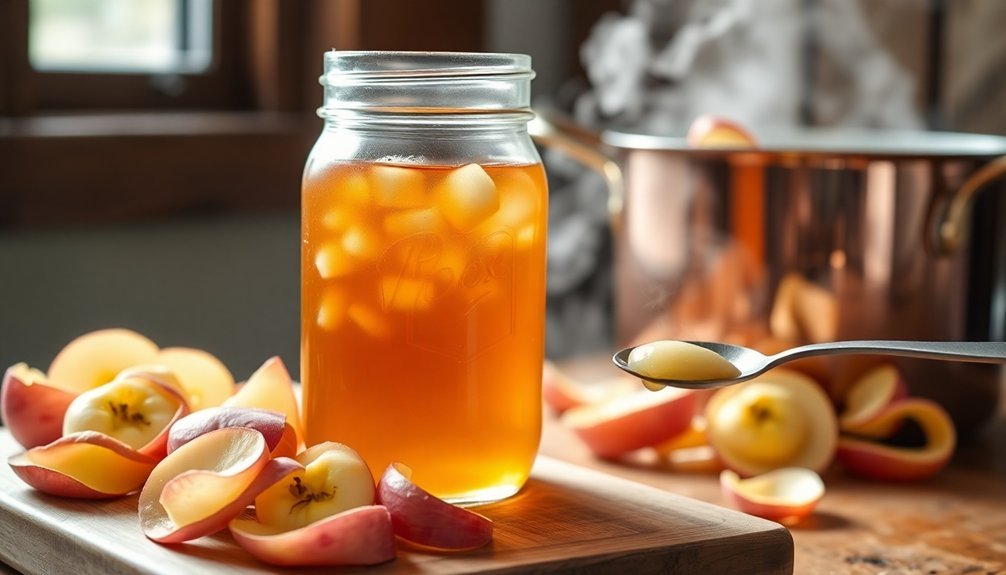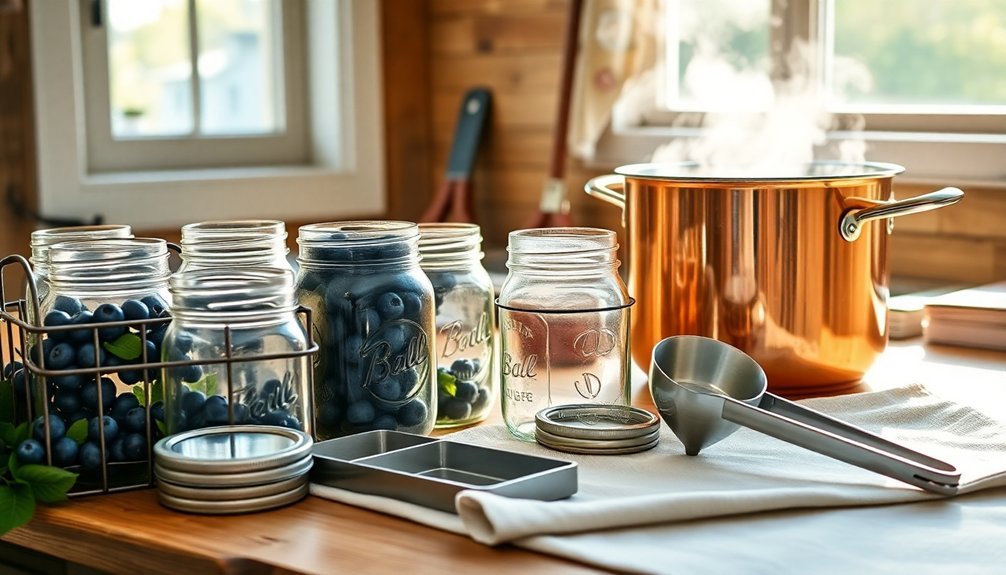If you're looking to extend the life of your winter vegetables, you'll need more than just any storage container. The right root cellar storage bin can mean the difference between crisp, flavorful produce and spoiled disappointment. While traditional methods still work, modern solutions offer innovative features that make storing your harvest easier and more efficient. Let's explore seven exceptional storage options that'll help you preserve your vegetables through the coldest months.
Boston Warehouse Root Vegetable Storage Set
The Boston Warehouse Root Vegetable Storage Set delivers a practical storage solution for kitchen organizers who need to keep their root vegetables fresh while adding farmhouse charm to their countertops.
You'll find three iron canisters perfectly sized for your staples: a potato bin holding up to 5 pounds, an onion container fitting 3 pounds, and a garlic keeper for 6-7 heads. The die-cut floral pattern promotes airflow to prevent sprouting, while the easy-lift lids allow quick access. Though the lids fit loosely, they complement the ventilation design. At 4.4 stars from 229 reviews, customers praise its lightweight construction and attractive appearance, making it an ideal gift for new homeowners.
Best For: Home cooks and kitchen organizers who want to store root vegetables with style while maintaining freshness and adding a decorative farmhouse touch to their countertops.
Pros:
- Attractive die-cut floral pattern provides both ventilation and visual appeal
- Three perfectly sized containers for common root vegetables (potatoes, onions, and garlic)
- Durable iron construction contains dirt and vegetable debris while remaining lightweight
Cons:
- Loose-fitting lids may not provide optimal seal for vegetable preservation
- May retain more moisture compared to traditional terracotta storage options
- Hand wash only maintenance requirement adds to cleaning effort
Gardeners Supply Company Root Storage Bin for Fruits & Vegetables
Gardening enthusiasts seeking a compact storage solution will find the Gardeners Supply Company Root Storage Bin ideal for preserving their harvest. The 18" x 12.5" x 8.5" bin features a sturdy metal wire frame wrapped in breathable burlap jute, helping maintain peak air circulation for your vegetables.
You'll appreciate how simple it is to set up—just connect the corners and fit the liner. For best results, store your root vegetables in alternating layers of damp sand or sawdust, though potatoes and squash can go directly in the bin. With a 4.6-star rating, customers praise its durability and effectiveness, though some mention liner-fitting issues.
Best For: Home gardeners and small-scale farmers who need an organized, breathable storage solution for their root vegetables and want to extend their harvest's shelf life.
Pros:
- Sturdy metal frame with breathable burlap construction promotes ideal air circulation
- Compact size fits well in storage rooms or kitchen spaces
- Easy assembly with no tools required and includes satisfaction guarantee
Cons:
- Some users report issues with proper liner fitting
- Limited size may not be sufficient for larger harvests
- Requires additional materials (sand/sawdust) for optimal storage of some vegetables
Gardeners Supply Company Stacked Root Storage Bins Set
Perfect for space-conscious homesteaders who want to preserve root vegetables longer, this three-piece stacked storage set from Gardeners Supply Company combines practicality with smart design.
Each bin features breathable jute liners and wire construction that promotes airflow while blocking light – essential conditions for root vegetable storage. The sturdy mango wood lids allow you to stack the bins vertically, and they'll nest together when not in use. You'll get three different sizes: large (21"L x 13"W), medium (19.5"L x 11"W), and small (17"L x 9"W).
While the concept is promising, some users report issues with mold, suggesting you'll need to monitor moisture levels carefully.
Best For: Home gardeners and small-scale farmers who need an organized, space-efficient storage solution for root vegetables and want to extend their harvest's shelf life.
Pros:
- Stackable design with three different sizes maximizes vertical storage space
- Breathable jute liners and wire construction provide ideal air circulation
- Attractive mango wood lids double as stacking platforms and protect contents from light
Cons:
- Poor customer ratings (3.3/5) suggest potential performance issues
- Reports of mold problems indicate moisture control challenges
- Not water resistant, which could limit durability and cleaning options
ARTAWEIN Pine Wood Veggie Storage Bin for Potato, Onion & Garlic
Crafted from premium rustic pine wood, ARTAWEIN's veggie storage bin offers a stylish solution for homeowners who want to keep their produce fresh while enhancing their kitchen's aesthetic appeal. The fully assembled unit features dedicated compartments for potatoes, onions, and garlic, with space for up to 10 pounds of produce.
You'll appreciate the bin's practical design, measuring 13.77" L x 7.1" W x 29.3" H, which maximizes counter space while promoting ideal air circulation. The rustic gray finish and smooth, wipe-clean surfaces make maintenance effortless. While some users note limitations with the garlic drawer size, you can easily mount this farmhouse-style organizer to your wall for added versatility.
Best For: Home cooks and kitchen enthusiasts who value both functionality and aesthetics while seeking an organized, space-efficient storage solution for root vegetables and garlic.
Pros:
- Attractive rustic design that enhances kitchen decor while providing practical storage
- Arrives fully assembled with wall-mounting capability for flexible placement
- Promotes proper air circulation to help maintain produce freshness
Cons:
- Limited storage capacity (10 lbs) may not suit larger households
- Garlic drawer size reported as smaller than expected
- Premium price point compared to basic storage solutions
Gardeners Supply Company Orchard Garden Harvest Rack (6 Drawer Storage Cabinet)
This sturdy six-drawer storage cabinet proves ideal for homesteaders and serious gardeners who need to store their harvest throughout the winter months. Made from untreated Chinese fir, the rack measures 23.5" deep by 24.5" wide by 39.5" high and features a design that promotes air circulation while reducing dust.
You'll find it perfect for storing potatoes, onions, winter squash, apples, and herbs in a cool, dark cellar or shed. While assembly requires basic tools and two people, you can complete it quickly. Despite some concerns about wood smell and sap, customers praise its sturdiness and aesthetic appeal. The rack's versatility extends beyond produce storage – you can use it for home-canned goods or as a drying rack.
Best For: Homesteaders, gardeners, and anyone with a need to store and organize fresh produce, root vegetables, or home-canned goods in a cool, dark space.
Pros:
- Spacious six-drawer design with good air circulation for optimal produce storage
- Versatile usage options, including produce storage, drying rack, and home-canned goods storage
- Quick and straightforward assembly process with included instructions
Cons:
- Reports of wood smell and sap oozing from the untreated Chinese fir
- Concerns about packaging materials containing fiberglass
- Requires two people for assembly and basic tools like a drill and screwdriver
Clear Plastic Pantry Storage Organizer with Lid (2 Set)
Storage-savvy homeowners will appreciate these versatile clear plastic organizers that combine functionality with smart design. Each set includes two stackable bins with bamboo lids that double as cutting boards.
You'll love the wide front opening that makes grabbing produce effortless, while the food-safe PET construction and BPA-free materials keep your items fresh. The bins' anti-tilt feature guarantees stability when stacked, maximizing your storage space.
At 12"L x 7"W x 7"H, they're ideal for storing potatoes, onions, garlic, and other root vegetables. While they're not dishwasher safe, these bins' hand-washable design and clear walls make maintenance simple while letting you monitor your produce's freshness.
Best For: Home organizers and meal preppers who want clear, stackable storage solutions for their pantry items while maximizing counter and cabinet space.
Pros:
- Versatile storage bins with bamboo lids that double as cutting boards
- Clear walls allow easy visibility of contents while maintaining freshness
- Space-efficient stackable design with anti-tilt feature for secure stacking
Cons:
- Hand wash only – not dishwasher safe
- Size may be limiting for larger produce items
- Limited depth at 7 inches might restrict storage capacity for some items
Beautiful Potato and Onion Storage Container Set for Kitchen Counter
Modern homeowners seeking both style and functionality will love this elegant potato and onion storage container set. The powder-coated metal bins feature built-in ventilation holes and wooden lid handles, blending seamlessly with both contemporary and farmhouse décor.
The larger bin holds up to 10 pounds of potatoes, while the smaller one stores 7 pounds of onions. You'll find these dimensions perfect for countertop or pantry placement, measuring 10.1×7.5×7.2" and 8.9×6.5×6.2" respectively. With an impressive 4.8-star rating, customers praise its storage efficiency and ability to keep produce fresh longer.
Best For: Home cooks and kitchen organizers who want attractive, functional storage solutions that keep produce fresh while enhancing their kitchen's aesthetic appeal.
Pros:
- High-quality powder-coated metal construction with proper ventilation ensures produce stays fresh longer
- Attractive design with wooden handles complements both modern and farmhouse kitchen décor
- Generous capacity with perfectly sized bins for typical household potato and onion storage needs
Cons:
- At 3.58 pounds when empty, the set may be somewhat heavy for some users to move when full
- Premium price point compared to basic storage solutions
- Limited color options may not match all kitchen color schemes
Factors to Consider When Choosing Root Cellar Storage Bins for Winter Vegetables
When you're selecting storage bins for your root cellar, you'll need to evaluate key features that protect your winter vegetables throughout the cold months. Your chosen bins should have proper ventilation holes for air circulation, sturdy materials that resist moisture damage, and sufficient capacity to accommodate your harvest without overcrowding. The ideal storage solution will also help maintain consistent temperatures while managing moisture levels to prevent rot and extend the life of your produce.
Ventilation and Air Circulation
Since the success of root cellar storage heavily depends on proper airflow, selecting bins with adequate ventilation features is essential for preserving your winter vegetables. Look for storage containers that incorporate die-cut patterns or breathable liners, as these design elements promote vital air circulation throughout your stored produce.
You'll want to choose bins with an open design or ventilated lids that prevent heat and moisture from getting trapped inside. This airflow helps protect your root vegetables from mold and reduces spoilage risk. For items like potatoes, onions, and garlic, proper ventilation can greatly delay sprouting and extend storage life. Make it a habit to check your storage bins regularly, ensuring there's sufficient air exchange. With well-ventilated containers, you'll maintain fresher produce throughout the winter months.
Material and Durability Properties
The right material choice for your root cellar storage bins plays an essential role in preserving vegetables throughout winter. You'll find that metal bins offer exceptional durability and moisture resistance, though you'll need to guarantee proper ventilation to prevent rust formation. If you prefer a more traditional look, hardwood bins made from mango or pine not only enhance your cellar's aesthetics but also provide natural airflow to keep your produce fresh.
For a lighter option, consider burlap jute liners, which offer excellent breathability. However, you'll need to clean them more frequently than solid materials. Whichever material you choose, focus on robust construction features like sturdy frames and well-fitted lids. Look for designs that allow easy access while maintaining adequate ventilation to prevent spoilage.
Size and Storage Capacity
Selecting the right storage capacity starts with understanding your winter vegetable needs. You'll want to choose bins that can accommodate your typical produce quantity – a standard potato canister holds about 20 medium potatoes or a 5 lb bag, while larger bins can store up to 10 lbs.
Consider bins with dedicated compartments if you're storing different vegetables together. These compartments keep potatoes, onions, and garlic separated, which helps maintain freshness and prevents cross-contamination. When measuring your space, look at both the bin's footprint and its storage volume. If you've got limited counter space, compact designs with efficient air circulation might be your best choice. For bulk storage, larger bins offer more capacity while still ensuring proper ventilation to keep your vegetables fresh throughout winter.
Temperature Control Features
Maintaining proper temperature control stands as a critical factor when choosing root cellar storage bins for your winter vegetables. You'll want bins that can consistently sustain temperatures between 32°F and 40°F to maximize your produce's shelf life.
Look for storage bins with built-in ventilation features that promote air circulation, preventing unwanted moisture buildup. Double-walled or insulated designs will help shield your vegetables from external temperature fluctuations. You'll also benefit from bins made with temperature-regulating materials like wood or those featuring breathable fabric liners.
When setting up your storage system, place your bins away from heat sources. Whether you're storing carrots, potatoes, or other root vegetables, proper temperature control will guarantee they stay fresh throughout the winter months.
Moisture Management Capabilities
Along with temperature control, proper moisture management plays an essential role in preserving your root vegetables throughout winter storage. You'll want to choose storage bins that feature breathable materials like burlap or containers with die-cut patterns that promote air circulation. These designs help maintain suitable moisture levels while preventing excess humidity that can lead to spoilage.
Consider bins with open-top designs, as they provide better ventilation compared to sealed containers. For enhanced moisture control, you can layer your vegetables with damp sand or sawdust, creating an ideal environment that prevents both dehydration and mold growth. Remember to monitor moisture levels regularly and maintain proper airflow around your storage containers. These moisture management features will greatly extend your vegetables' shelf life through the winter months.
Stackability and Space Efficiency
When space is at a premium in your root cellar, stackable storage bins offer a practical solution for maximizing vertical storage capacity. You'll find that these bins make efficient use of limited space while keeping your vegetables organized and accessible throughout the winter months.
Look for bins that feature anti-tilt designs to guarantee your stacked containers remain stable and secure. You'll appreciate how many root storage bins can nest within each other when they're not in use, saving valuable space during off-seasons. This stackable design doesn't just save space – it also promotes proper air circulation around your stored vegetables, which is essential for maintaining freshness. You can easily separate different types of produce while keeping everything visible and within reach, making your root cellar storage system both practical and efficient.
Frequently Asked Questions
How Deep Should a Root Cellar Be for Optimal Vegetable Storage?
You'll want your root cellar 6-10 feet deep underground, where temperatures stay steady between 32-40°F. This depth maintains ideal humidity and provides enough insulation to keep your vegetables fresh through winter.
Can I Store Different Vegetables Together in the Same Bin?
You'll need to separate your vegetables carefully. Don't store apples with other produce as they release ethylene gas. Group root vegetables together, and keep onions and potatoes apart to prevent premature sprouting.
What's the Ideal Humidity Level for Storing Root Vegetables?
You'll want to maintain a humidity level between 85-95% for most root vegetables. If you're storing them in your cellar, use a hygrometer to monitor moisture and add water-filled containers if needed.
How Often Should I Check Stored Vegetables for Signs of Spoilage?
You'll want to inspect your stored vegetables at least once a week. Look for soft spots, mold, or unusual odors. Remove any spoiled items immediately to prevent decay from spreading to other produce.
What Natural Materials Can I Use to Prevent Mold Growth?
You can use cedar shavings, dried bay leaves, and diatomaceous earth as natural mold inhibitors. Sprinkle coarse salt around storage areas, and add cinnamon sticks or cloves to naturally fight fungal growth.
In Summary
Choose the right root cellar storage bin that'll transform your winter vegetable storage game. You'll save money by preventing food waste and enjoy fresh produce throughout the cold months. Whether you've picked the Boston Warehouse set for style or Gardeners Supply Company's bins for durability, you're now equipped to store your harvest properly. Don't forget to take into account ventilation, size, and moisture control for best results.





Leave a Reply